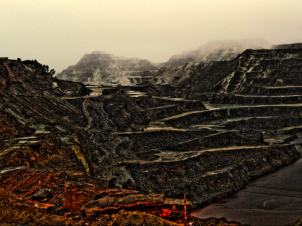
As we feared in a recent opinion piece, the US Supreme Court’s decision to unarm the Alien Tort Statue (ATS) creates a fall-out for environmental justice cases worldwide. One and a half years ago we wrote about the victims of Rio Tinto’s human rights abuses in Papua New Guinea – who were trying to get justice in the US. But after 13 years of legal struggle, Rio Tinto managed to get rid of this thorny issue – exactly because the ATS has been unarmed in the Kiobel case and no longer applies to violations committed outside of U.S. soil. Roughly 10,000 current and former Bougainville residents now have little hope to make Rio Tinto accountable for the massive human rights violations and thousands of deaths linked to their resistance against environmental crimes in the copper and gold mine that Rio Tinto once ran.
In 1969, during Australian administration of the Bougainville island as a UN Trust Territory, Conzinc Rio Tinto Australia (CRA) opened a large copper and gold mine with forced community evictions. In 1971, with pollution caused by the mine spreading, the issue of compensation went to the High Court of Australia. They ruled that the compensation was inadequate under ordinary federal Australian law, but that as an external territory, Papua New Guinea was not guaranteed the same standards that applied to mainland Australia. That was just the start of a grueling story of double standards and injustice.
The mine closed in 1989, when the by then armed victims took it over and an eight-year guerrilla war ensued. The government, directly supported by the Australian military, proceeded with aerial bombing, village-burning and other acts of retaliation. A sea-embargo was supposed to get the islanders on their knees in a few weeks time, but was given up 8 years and thousands of deaths later. The legal claim, filed by a Seattle lawyer, Steve Berman, alleges that the company brought financial influence to bear on Papua New Guinea’s government, which is accused by the plaintiffs of killing 15,000 islanders. But the prospect of justice is looking increasingly dim.
The Supreme Court’s April 17 decision in Kiobel v. Royal Dutch Petroleum Co has thus become a sad precedent. For three decades, lawyers and human rights activists have used the ATS as a way to hold multinationals accountable for a variety of human right abuses. Had it been replaced by a well functioning international environmental court where anyone could hold multinationals accountable, nobody would have missed the powers of the ATS. But with the new limits on cases that can be brought under ATS and the continuing lack of a global forum for environmental justice – justice for these corporate crimes appears ever more elusive .
More info:
The case is part of EJOLTs database on environmental conflicts and will be part of the global map launched late 2013.
A multiple award winning documentary on the revolution against Rio Tinto: http://en.wikipedia.org/wiki/The_Coconut_Revolution
A website dedicated to the history of this ‘ecological revolution’:
http://www.eco-action.org/ssp/bougainville.html
An analysis on the consequences of the Kiobel ruling for the use of the ATS:
Here is another case affected by the Kiobel ruling:
http://www.earthrights.org/blog/international-day-support-victims-torture-federal-judge-gives-corporate-torturers-free-pass
http://uk.reuters.com/article/2013/06/28/uk-riotinto-abuse-lawsuit-idUKBRE95R0Z520130628
Photo Credit: By Xavier86 from Flickr

The project ENVJUSTICE has received funding from the European Research Council (ERC) under the European Union’s Horizon 2020 research and innovation programme (grant agreement No. 695446)